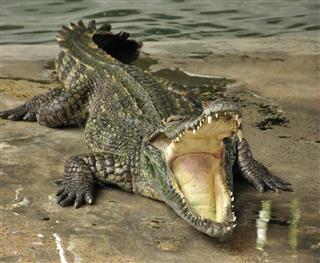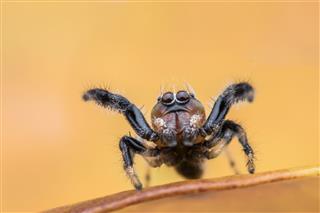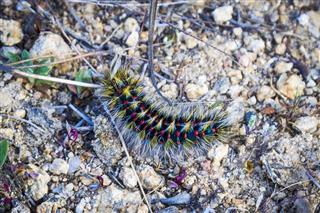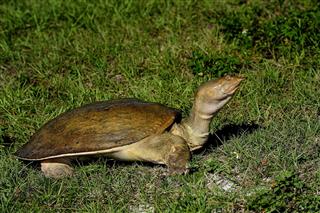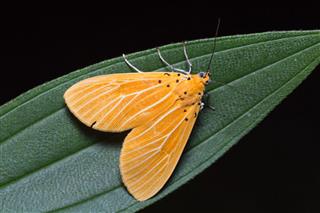
That the lengthy list of cold-blooded animals is dominated by reptiles and amphibians shouldn’t really come as a surprise, considering that nearly all animals in these groups are ectotherms. As you go through some examples provided in this AnimalSake article, you will get a better idea as to which species are considered cold-blooded.
Warm-blooded vs. Cold-blooded
A prominent difference between a warm-blooded animal and a cold-blooded animal is that the former can stay active in winter, the latter can’t; not without risking its life at least.
That there are no snakes in Antarctica is a well-known fact. They cannot survive in the freezing conditions of Antarctica, or the Arctic for that matter. Nor can turtles, crocodiles, and other species that are classified as ‘cold-blooded animals’. So what is with these species that makes it impossible for them to survive in cold regions? The answer is their inability to control the temperature of their body.
Cold-blooded Animals
Cold-blooded animals or ectotherms are animals that lack an internal physiological mechanism to regulate their body temperature and thus, rely on the temperature of their surroundings for the same. Most of these species are found in areas where the temperature is more or less stable. As for those species which are found in areas with extreme climate, they have a whole lot of behavioral adaptations to help them survive.
Except for mammals and birds, which are warm-blooded, nearly all species found on the planet are cold-blooded. That will include reptiles, amphibians, arachnids, insects, and certain species of fish as well. That makes it difficult to compile a list of animals which will include every cold-blooded animal, unless you are writing a book of course. An easier way out is to take each of these groups individually and see how these animals cope with their surroundings.










Reptiles
Being cold-blooded, it is mandatory for reptiles to warm up to perform certain body functions, including digestion and locomotion. In order to accomplish this, most reptiles, like lizards, snakes, and crocodiles, bask in the sun. For lizards and crocodiles, lying perpendicular to the direction of the Sun is the simplest way of elevating their body temperature above the ambient temperature. Lizards can even expand their rib cage to increase the surface area of their body and darken their skin color to absorb more heat. Even snakes can expand their body to increase the surface area. When it is very hot, these species do the exact opposite, i.e, take shelter in shade or burrow, lie parallel to the sun’s rays, and lighten their skin color.
In the morning, these species choose to bask on rocks or plants. The soil, with all that dew on it, doesn’t serve the purpose. Rocks are favorable as they dissipate heat. In the evening, snakes and lizards rest on rocks, which continue to dissipate heat even after sunset, before returning to the warmth of their burrows.
As you must have noticed, alligators and crocodiles keep their jaws wide open while basking. The resultant evaporative cooling helps them keep their brain cool, even as the rest of the body becomes warm. Similarly, collared lizards run on their hind legs to produce artificial breeze to cool down when the temperature soars. In winter, turtles take shelter under rocks at the bottom of lakes and rivers. Instead of coming to the surface to breathe, they absorb oxygen that is dissolved in the water through their cloaca.
Amphibians
Despite the fact that they are cold-blooded, amphibians are found in a wide range of habitats, right from the Arctic to the tropical rainforests. The group is largely made up of frogs, which resort to estivation or hibernation to survive harsh weather. Those species of frogs that estivate become dormant and burrow into the soil to survive dry season, only to return to the surface when it starts raining. On the other hand, those species that hibernate go into a dormant state to survive the freezing winter. While terrestrial frogs hibernate on land, either digging into soil or finding crevices for themselves, aquatic frogs hibernate underwater.
Just hibernating is not enough, as the places where they hibernate are not totally protected. Therefore, frogs and other amphibians rely on chemical compounds, known as cryoprotectants, to minimize the damage that is caused to their body as a result of freezing. Salamanders, in contrast, simply move between warm and cold areas and let their surroundings do the needful. For them, moisture is perhaps more important than temperature.
Insects
Insects like bumble bees, dragonflies, and moths vibrate their flight muscles to increase their internal temperature. That is somewhat similar to us humans shivering in order to keep warm on a cold night. For most insect species, warming up is a necessity, as they cannot fly until the temperature of their flight muscles reaches a specific level. Therefore, we see them basking in the sun for sometime at the beginning of the day. Once in flight, they can raise the temperature to 80 °F and keep it steady throughout the flight.
As for caterpillars, they have to bask in the sun in order to elevate their body temperature above the ambient temperature. The tent caterpillars are named so because of their tendency to build a ‘tent’ where they bask in groups to elevate their body temperature on an otherwise cold spring morning. As for those insects that live in swarms, such as different species of bees, they stay warm by huddling into groups.
Arachnids
Spiders, scorpions, and other arachnids simply become less active when the temperature drops. If it is possible for scorpions to exist in the harshest places on the Earth, despite being cold-blooded, it is because of their ability to easily adapt to the changes in their surroundings. They will stay in their burrow when it’s too hot and surface the moment the conditions outside become favorable. Species of scorpions that are found in higher latitudes hibernate in winter.
That spiders are attracted to warmth and thus, come into the house on a cold night, is one of the several myths about the species. As with other cold-blooded species, even spiders find it difficult to survive in extreme weather regardless of whether it’s too cold or too hot. When it is too cold, they either burrow or resort to cryoprotectants to survive. Most species of centipedes and millipedes migrate when the weather is too hot or cold, others burrow into the ground.
Fish
There is a specific temperature range in which fish can survive. As with other ectotherms, when fish warm up, which invariably happens when they are in warm water, their metabolic rate increases, so they require more oxygen. However, as the water becomes warm, its ability to hold oxygen reduces, and thus, if the temperature is too high, fish can find it difficult to breathe and may even die. When the temperature of the water they inhabit becomes unbearable, fish move to other parts of the water body. If at all, they benefit from the fact that the change in the temperature of water happens slowly, giving them enough time to move out of there.
In order to survive, some species of fish bury themselves in the mud at the bottom of the water source, while others find a cooler area and take shelter there. Those species, which are found in higher latitudes, migrate to tropical waters or move deeper in winter. Like frogs and spiders, some fish species have cryoprotectants in their body to help them battle freezing winters.
Not all fish and reptiles are cold-blooded though. There do exist species which can regulate the temperature of certain organs of their body internally. The bluefin tuna, for instance, regulates the temperature of its internal organs by moving its muscles to produce heat. The great white shark can harness the heat its body produces from metabolism and use it to keep its organs warm. The leatherback sea turtle can generate heat by swimming constantly and even retain the same as a result of its large size, thus maintaining a warm body temperature even in cold water.
Cold-blooded animals require less energy to survive compared to warm-blooded animals. On the flip side, it becomes mandatory for them to warm up before indulging in any sort of physical activity, may it be hunting or fleeing from a predator.




